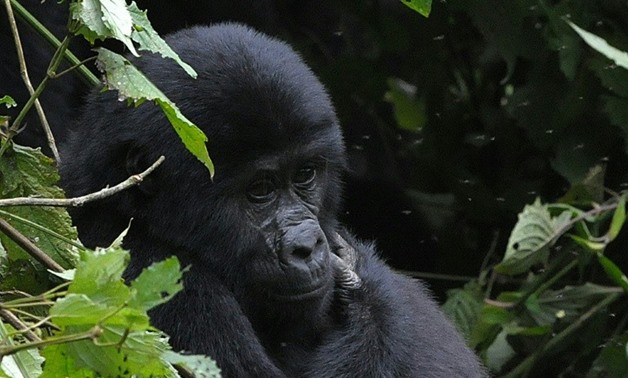
A female mountain gorilla sits in vegetation in the Bwindi Impenetrable Forest on the border of the Democratic Republic of Congo and Rwanda
26 April 2018: Gorillas and chimpanzees may be twice as numerous in West Africa as previously thought, but the apes are still endangered, declining fast and in dire need of protection, an international study found Wednesday.
Prior estimates were based on nest counts taken from isolated areas across the great apes' habitat range, said the report in the journal Science Advances.
The new count uses mathematical modeling to project likely ape numbers in areas where their nests haven't been directly surveyed by people.
The estimates are based on other factors known to influence ape numbers, such as proximity to roads and people, and recent outbreaks of Ebola virus which can be deadly.
Spanning 59 sites in five countries surveyed over 11 years, it is the most comprehensive and accurate dataset ever compiled on these apes, said one of the lead authors, Fiona Maisels, conservation scientist for the Wildlife Conservation Society.
The results show that western lowland gorillas in western equatorial Africa number nearly 362,000, up from prior estimates of 150,000-250,000 individuals.
And chimpanzees in the area are expected to number almost 129,000, up from earlier counts of 70,000 to 117,000.
- Still in danger -
But despite the larger numbers, researchers still found a speedy drop in the population in recent years, which means the apes are still in danger of going extinct.
Some 19.4 percent of the gorilla population was lost between 2005 and 2013, said the report.
At this rate, the gorilla population is expected to plunge 80 percent in just three generations.
Maisels said researchers are "pleased" to have a more accurate number, but cautioned that it does not change the gorillas' status as critically endangered on the International Union for Conservation of Nature (IUCN) Red List.
Nor does it change the characterization of chimpanzees as endangered.
"What we are worried about is the gorillas are going down to a tune of 2.7 percent per year," Maisels said.
"The other kind of worrying thing is that the majority of gorillas and chimps do not live in protected areas," she said.
As many as 80 percent of the great apes live outside protected areas, according to the study.
About 60 percent of all known gorillas and 43 percent of chimpanzees live in the Democratic Republic of Congo, while Gabon is home to 27 percent of the gorilla population and 34 percent of chimpanzees.
High densities of both apes also live in southern Cameroon.
Even though killing gorillas is illegal worldwide, hunting remains the top threat to survival, followed by disease and habitat loss.
More anti-poaching efforts are needed, both inside and outside protected areas, said the report.
Better land planning could help preserve the apes' high-quality habitat.
"Given that gorillas are more numerous and chimpanzees are more ecologically resilient than expected, and that large areas of ecologically functional great ape habitat remain, we are hopeful that robust conservation policies, well-managed parks, and responsible industrial practices can stop their declines and provide for secure and thriving populations," the study concluded.


Comments
Leave a Comment